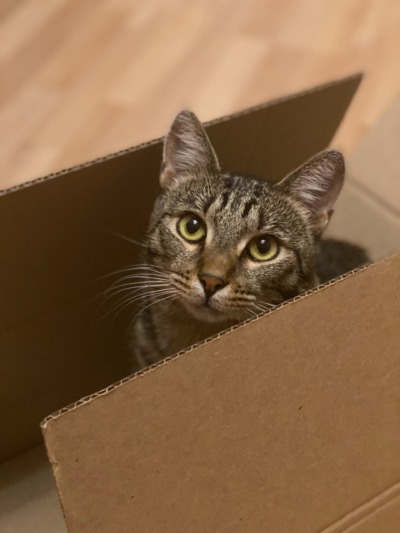
As Charles Dickens once said, “What greater gift than the love of a cat?”. There are many things to consider on whether cat adoption is right for you, and how to introduce a new cat into your home. Our walker Amy F. will discuss the basics of adopting your first cat from where to adopt, introducing them to your home, to litter and toys.
Are you ready for a new cat?
A new cat requires time and patience. It’s a huge responsibility, and can be costly as well. Costs include (but are not limited to) food, litter, bedding, vet expenses, spaying and neutering, toys, scratching posts, parasite control, vaccinations, and microchipping.
First, identify your lifestyle and needs before you adopt. Are you rarely home? If so, maybe consider an older, more independent cat. Are you a homebody? Then possibly a kitten might be the right choice since they require extra care and attention. Longhair cats require extra grooming and can produce more hairballs than shorthair cats. You should also expect certain personality traits from different breeds. Do your research about breed types and their personality traits, but keep in mind that many cats are domestic house cats, all of which are mixed breeds.
If you’re uncertain whether getting a cat is right for you but want to try out the responsibilities of owning a pet, consider becoming a foster parent! Check out our article on fostering pets for more information about these programs.
Where to adopt?
Once you’ve decided that you’re ready for a cat, consider where you’ll adopt your new family member from. Will you adopt from an animal shelter, a breeder, or a pet store?
Animal shelters can be a great option as they’re often less expensive and can evaluate a cat’s temperament. Shelters also often cover the costs of health checks, vaccinations, and spaying and neutering.
A breeder might be right for you if you require a cat with a specific temperament, or if you have allergies and need a hypoallergenic breed. If you decide a breeder is right for you, do your research and ensure they’re a reputable breeder. A reputable breeder ensures the pet’s safety and health and may take it back for any reason during the pet’s life.
Pet stores can be risky since many of them supply their pets from mills — for-profit breeding facilities that put fast turnaround above health standards. Not all pet stores are bad, though. For example, Petsmart and Petco have teamed up with government and local rescue groups to focus on adoptions. Before you adopt from a pet store, research where their pets come from and that they’re from an ethical source.
Houseplants and pet safety
Before bringing your cat home for the first time, check exactly what plants you have in your home. Your cat may become curious and try to eat them, but many common houseplants are toxic to cats, including species of lilies, tulips, and chrysanthemums. If your cat ingests a poisonous plant, there could be serious consequences, including vomiting, diarrhea, and cardiac arrest. For a comprehensive list of toxic plants, see this article from the ASPCA here.
Introducing a new cat to your home
All cats need time to adjust to their new home. Make sure you “cat-proof” your home and put away any small objects and exposed wire. Once you’ve cat-proofed and welcomed your new cat home, don’t expect them to warm up to you right away. Many cats hide during the first few days, if not the first week. Let your cat decide when they’re ready to approach you and your family members.
When bringing your cat home for the first time, place the carrier into the room and allow the cat to come out when they’re ready. Forcing an interaction with them when they’re incredibly stressed can hamper successful bonding. Bring a book with you and simply sit in the room with your cat, allowing them to get used to your presence. Hand-feeding treats can also help.
Consider setting up a safe space for your cat during the first few days or weeks. Designate a room in your home as their ‘home base’ and fill it with their food, litter, and belongings (If you live in a smaller space, check out our article on cat furniture for small apartments). The room should be peaceful and cozy. They should be able to hide if they wish. Don’t allow other pets or children into your cat’s designated space right away, as they’ll take time to adjust before exploring the rest of your home.
Litter and Food
When setting your cat’s litter box, make sure it’s away from loud noises and provides much-needed privacy. Veterinarians recommend one litter box per cat plus one. Consider the types of boxes and litter available. Many cats don’t like using covered boxes and have their own personal taste when it comes to litter. Good hygiene is just as crucial for your cat as it is for you, so scoop the litter box daily and replace litter weekly.
When it comes to food, remember that cats are carnivores and need meat. Whether you decide to go the route of dry kibble, wet food, raw diet, or a combination of all three, a high-quality diet will generally have high levels of animal protein, moderate fat, and limited carbohydrates. Check if your cat has any allergies or other food restrictions, and talk with your vet when making choices about what diet is best for your cat.
Playing with your cat
Your cat will need fun toys to play with! Toys help keep cats physically and mentally active and exercise their hunting instincts. While there are many toys to choose from, including laser lights and wands with ribbons or feathers, keeping your cat entertained can be inexpensive. Bottle caps and cardboard boxes can be just as stimulating as any store-bought toy. Cats also love catnip! You can use catnip in its raw leafy form, or in catnip-filled toys such as fuzzy balls and stuffed animals.
Once your cat gets comfortable with you and its new home, it’s only a matter of time before a lasting and loving relationship is formed between you and your new cat. Soon, you will experience the joy of owning a cat!
Thank you Amy for this comprehensive guide to bringing home your first cat! Windy City Paws is a Fear Free Chicago dog walker and petsitter committed to providing helpful information to Chicago dog (and cat!) owners through its blog.



